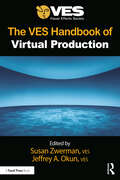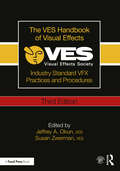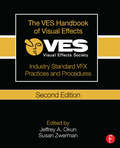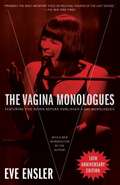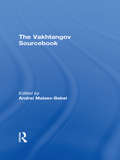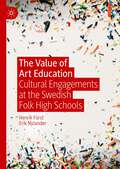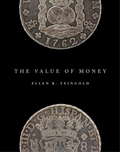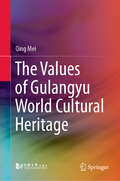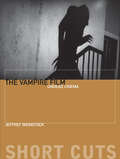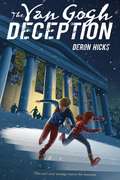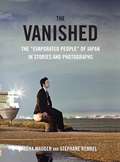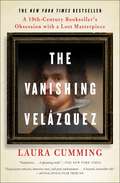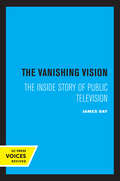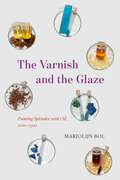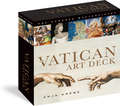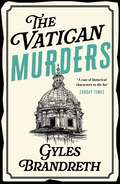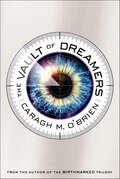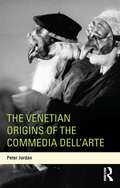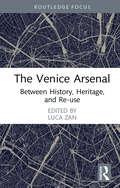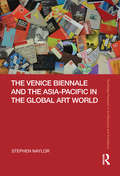- Table View
- List View
The VES Handbook of Virtual Production
by Jeffrey A. Okun Susan Zwerman Susan Thurmond O’NealThe VES Handbook of Virtual Production is a comprehensive guide to everything about virtual production available today – from pre-production to digital character creation, building a stage, choosing LED panels, setting up Brain Bars, in-camera compositing of live action and CG elements, Virtual Art Departments, Virtual Previs and scouting, best practices and much more. Current and forward-looking, this book covers everything one may need to know to execute a successful virtual production project – including when it is best to use virtual production and when it is not. More than 80 industry leaders in all fields of virtual production share their knowledge, experiences, techniques, and best practices. The text also features charts, technical drawings, color images, and an extensive glossary of virtual production terms. The VES Handbook of Virtual Production is a vital resource for anyone wishing to gain essential knowledge in all aspects of virtual production. This is a must-have book for both aspiring and veteran professionals. It has been carefully compiled by the editors of The VES Handbook of Visual Effects.
The VES Handbook of Virtual Production
by Jeffrey A. Okun Susan Zwerman Susan Thurmond O’NealOur handbook on Virtual Production is written in conjunction with the Visual Effects Society, guaranteeing the most expert advice in all areas of Virtual Production. It is a first of its kind handbook on this nascent technology, pooling insights from a vast array of different practitioners, to create a truly comprehensive reference book. It covers not only the software, hardware, and workflows, but also the types of jobs training needed for VP – the book starts from the ground up and provides an overview of what you need to learn before you use this technology.
The VES Handbook of Visual Effects: Industry Standard VFX Practices and Procedures
by Jeffrey A. Okun Susan Zwerman Christopher McKittrick Lisa Sepp-WilsonThe award-winning VES Handbook of Visual Effects remains the most complete guide to visual effects techniques and best practices available today. This new edition has been updated to include the latest, industry-standard techniques, technologies, and workflows for the ever-evolving fast paced world of visual effects. The Visual Effects Society (VES) tasked the original authors to update their areas of expertise, such as AR/VR moviemaking, color management, Cameras, VFX Editorial, Stereoscopic and the Digital Intermediate, as well as provide detailed chapters on interactive games and full animation. Additionally, 56 contributors share their best methods, tips, tricks, and shortcuts developed through decades of trial and error and real-world, hands-on experience. This 3rd edition has been expanded to feature lessons on 2.5D/3D Compositing; 3D Scanning; Digital Cinematography; Editorial Workflow in Animated and Visual Effects Features; Gaming updates; General Geometry Instancing; Lens Mapping for VFX; Native Stereo; Real-Time VFX & Camera Tracking; Shot/Element Pulls and Delivery to VFX; Techvis; VFX Elements and Stereo; Virtual Production; and VR/AR (Virtual Reality / Augmented Reality). A must-have for anyone working in or aspiring to work in visual effects, The VES Handbook of Visual Effects, Third Edition covers essential techniques and solutions for all VFX artists, producers, and supervisors, from pre-production to digital character creation, compositing of both live-action and CG elements, photorealistic techniques, and much more. With subjects and techniques clearly and definitively presented in beautiful four-color, this handbook is a vital resource for any serious VFX artist.
The VES Handbook of Visual Effects: Industry Standard VFX Practices and Procedures
by Jeffrey A. Okun Susan Zwerman Christopher McKittrick Lisa Sepp-WilsonThe award-winning VES Handbook of Visual Effects remains the most complete guide to visual effects techniques and best practices available today. This new edition has been updated to include the latest, industry-standard techniques, technologies, and workflows for the ever-evolving fast paced world of visual effects. The Visual Effects Society (VES) tasked the original authors to update their areas of expertise, such as AR/VR Moviemaking, Color Management, Cameras, VFX Editorial, Stereoscopic and the Digital Intermediate, as well as provide detailed chapters on interactive games and full animation. Additionally, 56 contributors share their best methods, tips, tricks, and shortcuts developed through decades of trial and error and real-world, hands-on experience.This third edition has been expanded to feature lessons on 2.5D/3D Compositing; 3D Scanning; Digital Cinematography; Editorial Workflow in Animated and Visual Effects Features; Gaming updates; General Geometry Instancing; Lens Mapping for VFX; Native Stereo; Real-Time VFX and Camera Tracking; Shot/Element Pulls and Delivery to VFX; Techvis; VFX Elements and Stereo; Virtual Production; and VR/AR (Virtual Reality / Augmented Reality).A must-have for anyone working in or aspiring to work in visual effects, The VES Handbook of Visual Effects, Third Edition covers essential techniques and solutions for all VFX artists, producers, and supervisors, from pre-production to digital character creation, compositing of both live-action and CG elements, photorealistic techniques, and much more. With subjects and techniques clearly and definitively presented in beautiful four-color, this handbook is a vital resource for any serious VFX artist.
The VES Handbook of Visual Effects: Industry Standard VFX Practices and Procedures
by Jeffrey A. Okun Susan ZwermanWisdom from the best and the brightest in the industry, this visual effects bible belongs on the shelf of anyone working in or aspiring to work in VFX. The book covers techniques and solutions all VFX artists/producers/supervisors need to know, from breaking down a script and initial bidding, to digital character creation and compositing of both live-action and CG elements. In-depth lessons on stereoscopic moviemaking, color management and digital intermediates are included, as well as chapters on interactive games and full animation authored by artists from EA and Dreamworks respectively. From predproduction to acquisition to postproduction, every aspect of the VFX production workflow is given prominent coverage. VFX legends such as John Knoll, Mike Fink, and John Erland provide you with invaluable insight and lessons from the set, equipping you with everything you need to know about the entire visual effects workflow. Simply a must-have book for anyone working in or wanting to work in the VFX industry.
The Vagina Monologues (10th Anniversary Edition)
by Eve Ensler"I was worried about vaginas. I was worried about what we think about vaginas, and even more worried that we don't think about them... So I decided to talk to women about their vaginas, to do vagina interviews, which became vagina monologues. I talked with over two hundred women. I talked to old women, young women, married women, single women, lesbians, college professors, actors, corporate professionals, sex workers, African American women, Hispanic women, Asian American women, Native American women, Caucasian women, Jewish women. At first women were reluctant to talk. They were a little shy. But once they got going, you couldn't stop them." So begins Eve Ensler's hilarious, eye-opening tour into the last frontier, the forbidden zone at the heart of every woman. Adapted from the award-winning one-woman show that's rocked audiences around the world, this groundbreaking book gives voice to a chorus of lusty, outrageous, poignant, and thoroughly human stories, transforming the question mark hovering over the female anatomy into a permanent victory sign. With laughter and compassion, Ensler transports her audiences to a world we've never dared to know, guaranteeing that no one who reads The Vagina Monologues will ever look at a woman's body the same way again.
The Vakhtangov Sourcebook
by Andrei Malaev-Babel‘Scrupulously compiled and skillfully translated by Andrei Malaev-Babel, The Vakhtangov Sourcebook ... provides the most comprehensive addition to English readers’ knowledge of the philosophy, pedagogy, and legacy of Vakhtangov.’ – Modern Language Review 'An exceptionally valuable book that promises to be the definitive reference for Vakhtangov's work for years to come.' – Theatre Topics Yevgeny Vakhtangov was the creator of Fantastic Realism, credited with reconciling Meyerhold’s bold experiments with Stanislavski’s naturalist technique. The Vakhtangov Sourcebook compiles new translations of his key writings on the art of theatre, making it the primary source of first hand material on this master of theatre in the English speaking world. Vakhtangov’s essays and articles are accompanied by: Diary and Notebook excerpts His lectures to the Vakhtangov Studio In-depth accounts of Vakhtangov methods in rehearsal Production photographs and sketches Extensive bibliographies Director’s notes on key performances An extensive introductory overview from editor Andrei Malaev-Babel explains Vakhtangov‘s creative life, his groundbreaking theatrical concepts and influential directorial works.
The Value of Art Education: Cultural Engagements at the Swedish Folk High Schools (Sociology of the Arts)
by Erik Nylander Henrik FürstThis book shows the continuing importance of art education. Art education attracts students who see multiple meanings and justifications for the worth of that education. Their engagement in art education is not limited to the uncertain prospects for jobs or routes into employment in the arts. Fürst and Nylander approach art education through a rich array of empirical examples derived from Swedish folk high school programs in music, visual arts, and creative writing. Based on an analytical framework of pragmatic sociology, the book allows the reader to understand the competences and critical capacities held by students and teachers. The book challenges the dominant public perception of art education and broadens our understanding of what it is good for. The Value of Art Education is essential reading for those defending the status of this vital sector of education, offering a deeper understanding of why people engage, what they gain, and the social importance of the arts.
The Value of Arts for Business
by Giovanni SchiumaThe traditional view of the relationship between business and the arts is very much a one-way affair: organisations may endorse, fund or publicise the arts but the arts have nothing to offer from a business perspective. The Value of Arts for Business challenges this view by showing how the arts, in the form of Arts-based Initiatives (ABIs), can be used to enhance value-creation capacity and boost business performance. The book introduces and explains three models that show how organisations can successfully implement and manage ABIs. Firstly, the Arts Value Matrix enables managers to see how organisational value-drivers are affected by ABIs. Secondly, the Arts Benefits Constellation shows how to assess the benefits of using ABIs. Finally, the Arts Value Map shows how ABIs can be integrated and aligned with organisational strategy and operations. These models lay the foundations for a new research area exploring the links between arts and business.
The Value of Money
by Ellen R. FeingoldThe Value of Money celebrates the power of using monetary objects to explore history. This richly illustrated book features over 175 objects from the Smithsonian National Museum of American History's National Numismatic Collection. With objects from every inhabited continent, spanning more than 2,600 years, this book showcases the National Numismatic Collection's unique strengths, including the geographic and chronological diversity of the collection and the stunning rarities it contains. The companion volume to a major exhibition of the same name, this book examines the origins of money, new monetary technologies, the political and cultural messages money conveys, numismatic art and design, and the practice of collecting money. The Value of Money connects American history to global histories of exchange, cultural interaction and expression, political change, and innovation.nge, cultural interaction, political change and innovation.
The Values of Gulangyu World Cultural Heritage
by Qing MeiThis book explores the core value of Gulangyu’s historical environment, using outstanding universal value and Sino-foreign cultural exchange as the framing aspects, based on the requirements for Gulangyu being recognized as a World Heritage Site. Using the existing historical buildings and sketches as prototypes, the book provides a scholarly discussion on China’s modern urban architecture and the ways in which its historical environment has been transformed, especially the reuse of design in its modern urban architecture, explored in six case studies on Gulangyu.
The Vampire Film
by Jeffrey WeinstockThis introductory volume offers an elegant analysis of the enduring appeal of the cinematic vampire. From Georges Méliès' early cinematic experiments to Twilight and Let the Right One In, the history of vampires in cinema can be organised by a handful of governing principles that help make sense of this movie monster's remarkable fecundity. Among these principles are that the cinematic vampire is invariably about sex and the vexed human relationship with technology, and that the vampire is always an overdetermined body condensing what a culture considers other. This volume includes in-depth studies of films including Powell's A Fool There Was, Franco's Vampyros Lesbos, Cronenberg's Rabid, Kümel's Daughters of Darkness, and Merhige's Shadow of the Vampire.
The Vampire Film: Undead Cinema (Short Cuts)
by Jeffrey WeinstockThis introductory volume offers an elegant analysis of the enduring appeal of the cinematic vampire. From Georges Méliès' early cinematic experiments to Twilight and Let the Right One In, the history of vampires in cinema can be organised by a handful of governing principles that help make sense of this movie monster's remarkable fecundity. Among these principles are that the cinematic vampire is invariably about sex and the vexed human relationship with technology, and that the vampire is always an overdetermined body condensing what a culture considers other. This volume includes in-depth studies of films including Powell's A Fool There Was, Franco's Vampyros Lesbos, Cronenberg's Rabid, Kümel's Daughters of Darkness, and Merhige's Shadow of the Vampire.
The Vamps: Official Book
by The VampsSince forming on YouTube in 2012, The Vamps have become one of the biggest bands in the UK. They have travelled the world with massive arena tours, sold hundreds of thousands of records, and gained legions of amazing and devoted fans. They have gone from schoolboys to superstardom in just a few years, and for the first time Connor, Brad, Tristan and James tell their story. From life on the road to dealing with their new-found fame, nothing is off-limits.Featuring exclusive behind-the-scenes photography, this is a fully-illustrated joint autobiography: the perfect book for any Vamps fan.
The Van Gogh Deception (The Lost Art Mysteries)
by Deron R. HicksDan Brown meets Jason Bourne in this riveting middle-grade mystery thriller. <P><P>When a young boy is discovered in Washington DC’s National Gallery without any recollection of who he is, so begins a high-stakes race to unravel the greatest mystery of all: his identity. <P><P>As the stakes continue to rise, the boy must piece together the disjointed clues of his origins while using his limited knowledge to stop one of the greatest art frauds ever attempted. <P><P>Digitally interactive, this breathtaking museum mystery offers QR codes woven throughout the book that bring renowned paintings to readers’ fingertips.
The Vanished: The "Evaporated People" of Japan in Stories and Photographs
by Léna Mauger Stéphane RemaelEvery year, nearly one hundred thousand Japanese vanish without a trace. Known as the johatsu, or the "evaporated,” they are often driven by shame and hopelessness, leaving behind lost jobs, disappointed families, and mounting debts. In The Vanished, journalist Léna Mauger and photographer Stéphane Remael uncover the human faces behind the phenomenon through reportage, photographs, and interviews with those who left, those who stayed behind, and those who help orchestrate the disappearances. Their quest to learn the stories of the johatsu weaves its way through: A Tokyo neighborhood so notorious for its petty criminal activities that it was literally erased from the maps Reprogramming camps for subpar bureaucrats and businessmen to become "better” employees The charmless citadel of Toyota City, with its iron grip on its employees The "suicide” cliffs of Tojinbo, patrolled by a man fighting to save the desperate The desolation of Fukushima in the aftermath of the tsunamiAnd yet, as exotic and foreign as their stories might appear to an outsider’s eyes, the human experience shared by the interviewees remains powerfully universal.
The Vanishing Velázquez: A 19th Century Bookseller's Obsession with a Lost Masterpiece
by Laura CummingFrom one of the world's most expert art critics, the incredible true story--part art history and part mystery--of a Velazquez portrait that went missing and the obsessed nineteenth-century bookseller determined to prove he had found it.When John Snare, a nineteenth-century provincial bookseller, traveled to a liquidation auction, he stumbled on a vivid portrait of King Charles I that defied any explanation. The Charles of the painting was young--too young to be king--and yet also too young to be painted by the Flemish painter to which the work was attributed. Snare had found something incredible--but what? His research brought him to Diego Velazquez, whose long-lost portrait of Prince Charles has eluded art experts for generations. Velazquez (1599-1660) was the official painter of the Madrid court, during the time the Spanish Empire teetered on the edge of collapse. When Prince Charles of England--a man wealthy enough to help turn Spain's fortunes--ventured to the court to propose a marriage with a Spanish princess, he allowed just a few hours to sit for his portrait. Snare believed only Velazquez could have met this challenge. But in making his theory public, Snare was ostracized, victim to aristocrats and critics who accused him of fraud, and forced to choose, like Velazquez himself, between art and family. A thrilling investigation into the complex meaning of authenticity and the unshakable determination that drives both artists and collectors of their work, The Vanishing Velazquez travels from extravagant Spanish courts in the 1700s to the gritty courtrooms and auction houses of nineteenth-century London and New York. But it is above all a tale of mystery and detection, of tragic mishaps and mistaken identities, of class, politics, snobbery, crime, and almost farcical accident. It is a magnificently crafted page-turner, a testimony to how and why great works of art can affect us to the point of obsession.
The Vanishing Vision: The Inside Story of Public Television
by James DayThis spirited history of public television offers an insider's account of its topsy-turvy forty-year odyssey. James Day, a founder of San Francisco's KQED and a past president of New York's WNET, provides a vivid and often amusing behind-the-screens history. Day tells how a program producer, desperate to locate a family willing to live with television cameras for seven months, borrowed a dime—and a suggestion—from a blind date and telephoned the Louds of Santa Barbara. The result was the mesmerizing twelve-hour documentary An American Family. Day relates how Big Bird and his friends were created to spice up Sesame Street when test runs showed a flagging interest in the program's "live-action" segments. And he describes how Frieda Hennock, the first woman appointed to the FCC, overpowered the resistance of her male colleagues to lay the foundation for public television. Day identifies the particular forces that have shaped public television and produced a Byzantine bureaucracy kept on a leash by an untrusting Congress, with a fragmented leadership that lacks a clearly defined mission in today's multimedia environment. Day calls for a bold rethinking of public television's mission, advocating a system that is adequately funded, independent of government, and capable of countering commercial television's "lowest-common-denominator" approach with a full range of substantive programs, comedy as well as culture, entertainment as well as information. This title is part of UC Press's Voices Revived program, which commemorates University of California Press’s mission to seek out and cultivate the brightest minds and give them voice, reach, and impact. Drawing on a backlist dating to 1893, Voices Revived makes high-quality, peer-reviewed scholarship accessible once again using print-on-demand technology. This title was originally published in 1995.
The Varnish and the Glaze: Painting Splendor with Oil, 1100–1500
by Marjolijn BolA new history of the techniques, materials, and aesthetic ambitions that gave rise to the radiant verisimilitude of Jan van Eyck’s oil paintings on panel. Panel painters in both the middle ages and the fifteenth century created works that evoke the luster of precious stones, the sheen of polished gold and silver, and the colorful radiance of stained glass. Yet their approaches to rendering these materials were markedly different. Marjolijn Bol explores some of the reasons behind this radical transformation by telling the history of the two oil painting techniques used to depict everything that glistens and glows—varnish and glaze. For more than a century after his death, the fifteenth-century painter Jan van Eyck was widely credited with inventing varnish and oil paint, on account of his unique visual realism. Once this was revealed to be a myth, the verisimilitude of his work was attributed instead to a new translucent painting technique: the glaze. Today, most theories about how Van Eyck achieved this realism revolve around the idea that he was the first to discover or refine the glazing technique. Bol, however, argues that, rather than being a fifteenth-century refinement, varnishing and glazing began centuries before. Drawing from an extensive body of recipes, Bol pieces together how varnishes and glazes were first developed as part of the medieval art of material mimesis. Artisans embellished metalwork and wood with varnishes and glazes to imitate gold and gems; infused rock crystal with oil, resin, and colorants to imitate more precious minerals; and oiled parchment to transform it into the appearance of green glass. Likewise, medieval panel painters used varnishes and glazes to create the look of enamel, silk, and more. The explorations of materials and their optical properties by these artists stimulated natural philosophers to come up with theories about transparent and translucent materials produced by the earth. Natural historians, influenced by medieval artists’ understanding of refraction and reflection, developed theories about gems, their creation, and their optical qualities.
The Vatican Art Deck: 100 Masterpieces
by Anja GrebeThe Vatican is one of the most popular destinations in the world, with more than 5 million visitors each year. It is also home to some of the world's greatest and most exquisite works of art. Its museums, palaces, and grounds house Michelangelo's Sistine Chapel and his Pietà, the Raphael frescoes, and the works of Giotto, Fra Angelico, Titian, and Caravaggio, as well as the world's finest statues, manuscripts, architecture, and gardens, and its most precious religious relics.The Vatican Art Deck includes 100 of the most iconic and significant works of art in the Vatican. Each entry includes a a full-size photograph of the art and a 200-word discussion by art historian Anja Grebe on the key attributes of the work; what to look for when viewing it; the artist's inspirations, techniques, and biographical information; the artist's impact on art history; and more. The work is also fully described with its title and the artist's name, the date of completion, the birth and death dates of the artist, the medium that was used, the size of the art (where applicable), the catalog number, and the museum in which the work of art can be found.Perfect for art lovers, students, and armchair travelers, The Vatican Art Deck is a guided tour through one of the most exquisite collections in the world.
The Vatican Murders: The Victorian Murder Mystery Series: 5 (The Victorian Murder Mystery Series #5)
by Gyles Brandreth'An exciting period murder mystery' Reader review ⭐⭐⭐⭐⭐'If you want a fun mystery to read, I highly recommend it' Reader review ⭐⭐⭐⭐⭐'Couldn't put it down!!' Reader review ⭐⭐⭐⭐⭐Does death await you in The Eternal City?1892: Arthur Conan Doyle is intrigued when he first begins to receive mysterious packages addressed to his famous fictional detective Sherlock Holmes.But the contents of the parcels are as gruesome and cryptic as any case Holmes himself tackled: a lock of hair, a severed finger wearing a gold ring, and the hand of a dead man.The only clue to who has sent them is the postmark from Rome.Doyle's friend and fellow author Oscar Wilde persuades him they must track down the perpetrator and identify the victims.Arriving in Italy, their investigation leads them to connect the parcels with the disappearance of a young girl and to the glittering Vatican City . . .With danger and death stalking them at every corner, can they unmask the killer before he catches up with them?A wonderfully witty and gripping cosy historical murder mystery with twists and turns aplenty. Perfect for fans of Sherlock Holmes, Agatha Christie and Richard Osman.Readers love The Vatican Murders:'The plot is constructed wonderfully . . . jumps off the page' Reader review ⭐⭐⭐⭐⭐'A truly enjoyable read from start to finish' Reader review ⭐⭐⭐⭐⭐'This is an excellent mystery series starring Oscar Wilde and Arthur Conan Doyle among others. Great plots with a mix of history and interesting characters. Totally entertaining' Reader review ⭐⭐⭐⭐⭐'Simply delightful' Reader review ⭐⭐⭐⭐⭐
The Vault of Dreamers (The Vault of Dreamers Trilogy #1)
by Caragh M. O'BrienThe Forge School is the most prestigious arts school in the country. The secret to its success: every moment of the students' lives is televised as part of the insanely popular Forge Show, and the students' schedule includes twelve hours of induced sleep meant to enhance creativity. But when first year student Rosie Sinclair skips her sleeping pill, she discovers there is something off about Forge. In fact, she suspects that there are sinister things going on deep below the reaches of the cameras in the school. What's worse is, she starts to notice that the ridges of her consciousness do not feel quite right. And soon, she unearths the ghastly secret that the Forge School is hiding—and what it truly means to dream there. From Caragh M. O'Brien, author of the Birthmarked trilogy comes the first book in a new series, The Vault of Dreamers, a fast-paced, psychologically thrilling novel about what happens when your dreams are not your own.
The Venetian Origins of the Commedia dell'Arte
by Peter JordanThe Venetian Origins of the Commedia dell'Arte is a striking new enquiry into the late-Renaissance stirrings of professional secular comedy in Venice, and their connection to the development of what came to be known as the Commedia dell’Arte. The book contends that through a symbiotic collaboration between patrician amateurs and plebeian professionals, innovative forms of comedy developed in the Venice region, fusing ‘high’ and ‘low’ culture in a provocative mix that had a truly mass appeal. Rich with anecdotes, diary entries and literary – often ribald – comic passages, Peter Jordan's central argument has important implications for the study of Venetian art, popular theatre and European cultural history.
The Venice Arsenal: Between History, Heritage, and Re-use (Routledge Research in the Creative and Cultural Industries)
by Luca ZanThis book reviews four decades of debate about restoring an industrial heritage site of inestimable value – the Venice Arsenal. Focusing on the challenges of economic, financial and institutional feasibility, it reveals how failing to address these aspects has undermined potential solutions from both technicians and heritage professionals. With a deep connection to the city over centuries, the Arsenal was the very basis of La Serenissima’s sea power, enabling its economic expansion. Later, it maintained a vital military function through shipbuilding until World War II. But the slow process of abandonment of the traditional site’s uses and spaces continues to pose questions regarding its preservation and re-use. Drawing on original research from urban planners, architects and historians, the book provides a critical investigation into the organizational and managerial challenges of this unique site, and crucially, why so little has been achieved compared with potential opportunities. Featuring numerous color photographs and exploring the particular challenges of restoration and re-use facing the Venice Arsenal, this insightful evaluation of the history of this site provides a uniquely informative case for the discipline of industrial heritage.
The Venice Biennale and the Asia-Pacific in the Global Art World (Routledge Research in Art Museums and Exhibitions)
by Stephen NaylorThis monograph uses the national pavilions of the Venice Biennale as a vehicle to examine the development of international contemporary art trends within the Asia-Pacific region, including Australia, Japan and Korea and 16 additional national entities who have had less continuous participation in this global art event. Analysing both the spatial and visual representation of contemporary art presented at the Venice Biennale and incorporating the politics behind national selections, this monograph provides insights into a range of important elements of the global art industry. Areas analysed include national cultural trends and strategies, the inversion of the peripheral to the centre stage of the Biennale, geopolitics in gaining exhibition space at the Venice Biennale, curatorial practices for contemporary art presentation and artistic trends that seek to deal with major economic, cultural, religious and environmental issues emerging from non-European art centres. This monograph will be of interest to scholars in art history, museum studies and Asia-Pacific cultural history.
